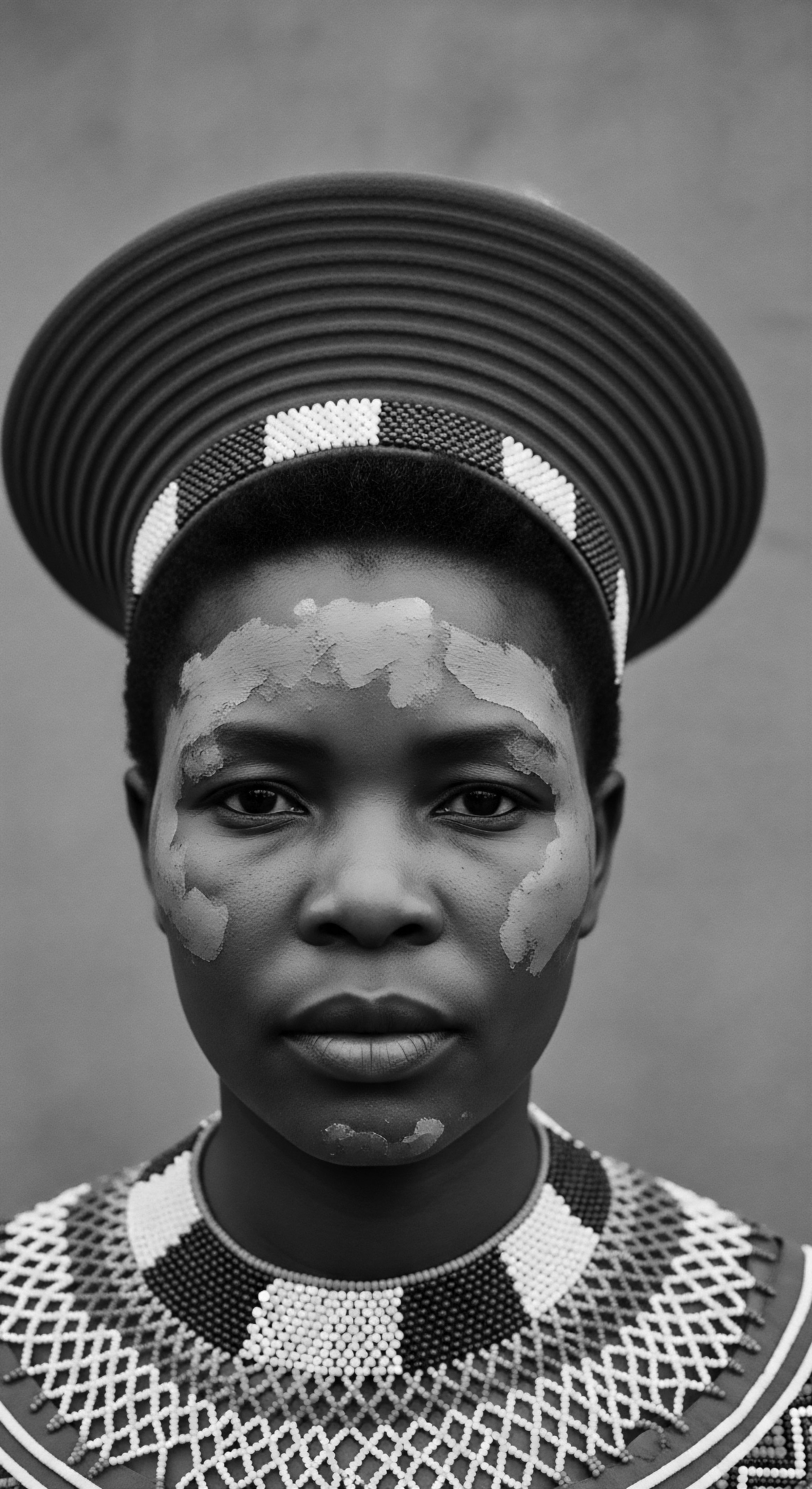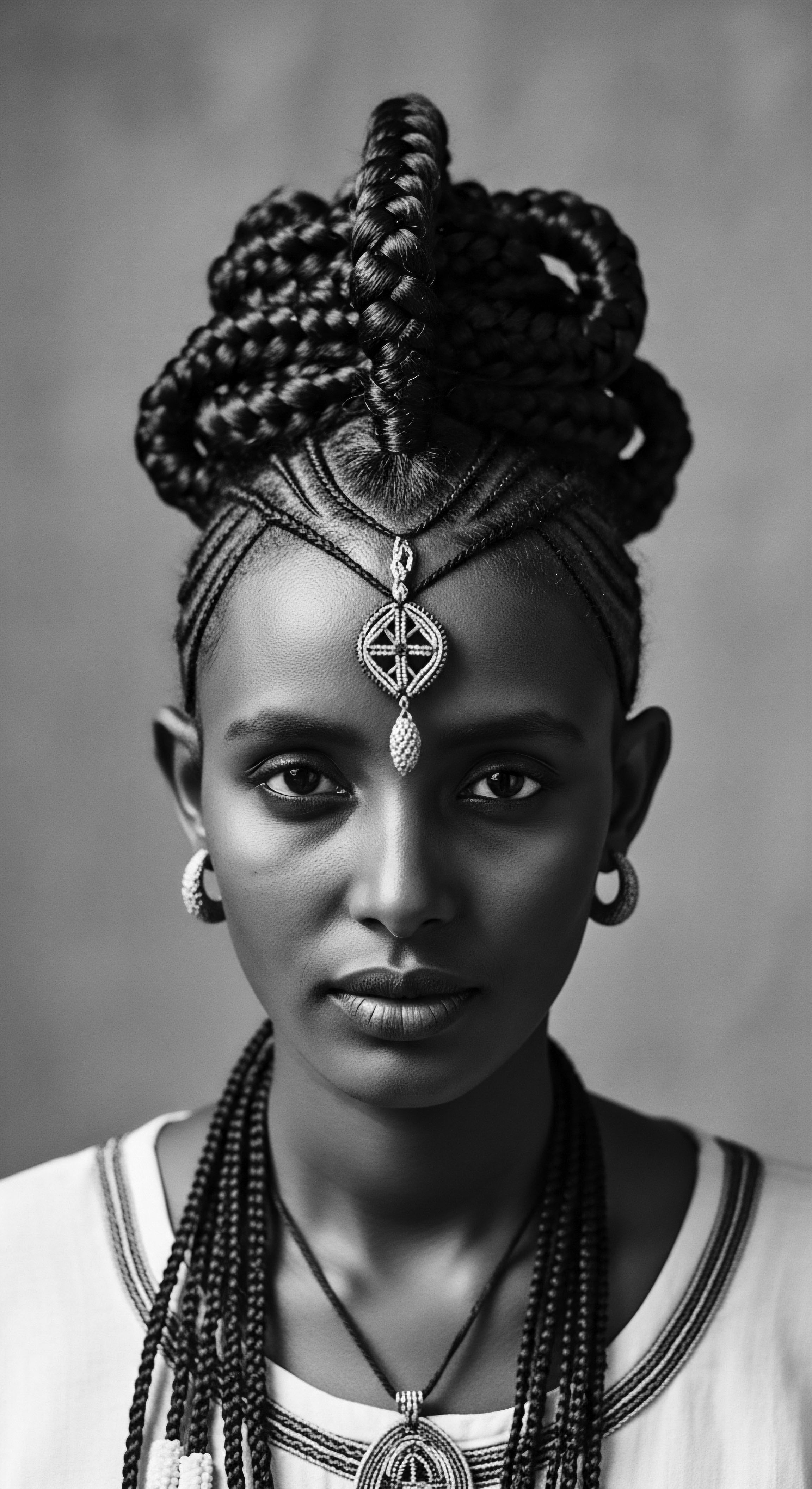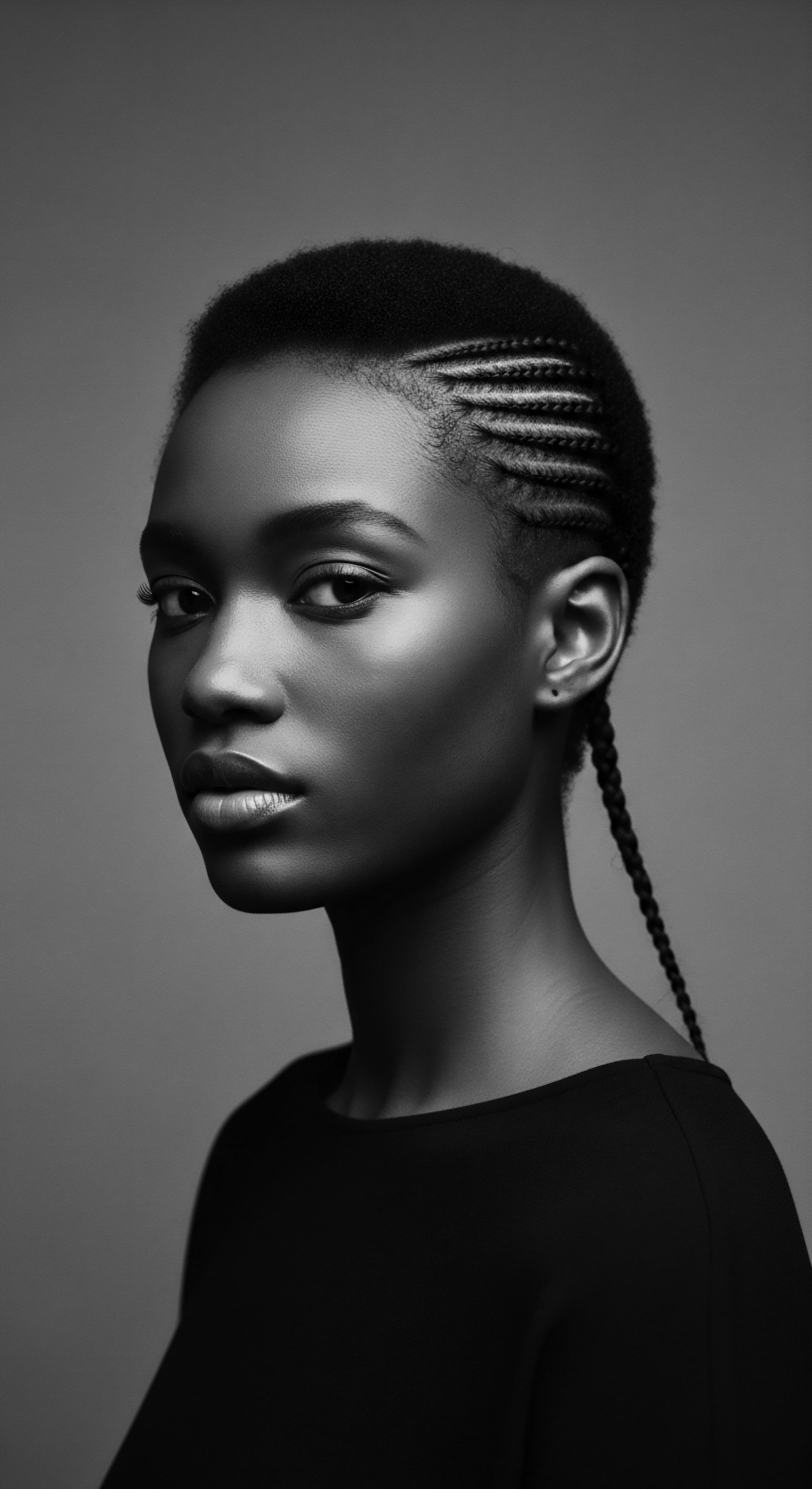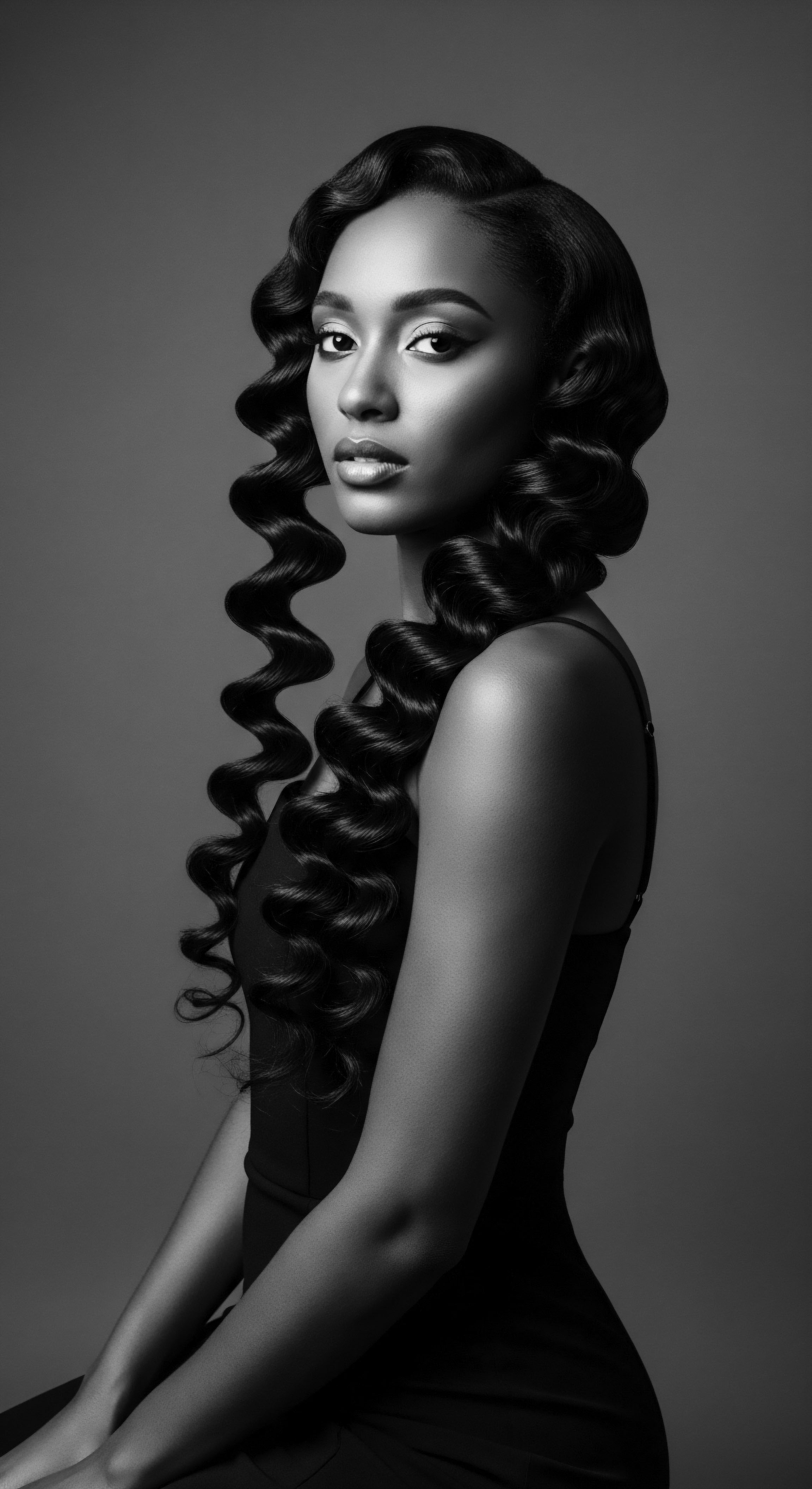
Fundamentals
The Cultural Heritage, as understood within Roothea’s living library, refers to the profound and enduring collection of inherited knowledge, practices, and expressions surrounding textured hair, particularly for Black and mixed-race communities across the globe. This understanding begins not as a static concept, but as a dynamic, flowing river of ancestral wisdom, deeply rooted in the earliest human experiences. Its fundamental meaning is inextricably tied to the intimate relationship between hair and identity, a connection forged over millennia on the African continent. For ancestral communities, hair was never merely an adornment; it served as a powerful medium of communication, a chronicle of one’s journey, and a sacred link to the spiritual realm.
From the earliest recorded histories, hair provided a visual language, a tangible expression of a person’s place within their community. This living archive of hair practices, passed down through generations, embodies the resilience and creativity of those who first understood the unique properties of textured hair. The practices of washing, oiling, braiding, and adorning hair were not simply acts of grooming; they were social rituals, spiritual observances, and markers of profound communal belonging.
Cultural Heritage, in the context of textured hair, is the ancestral blueprint of care, identity, and expression, etched into every coil and strand across generations.

Ancestral Echoes ❉ The Earliest Expressions
In pre-colonial African societies, hair held immense significance, reflecting social status, age, marital status, ethnic identity, religion, wealth, and even one’s surname. Hairstyles could identify a geographic region or a specific tribe. For instance, in the Wolof culture of Senegal, young girls would partially shave their heads to signify they were not yet courting.
The Karamo people of Nigeria were recognized by their distinctive coiffure ❉ a shaved head with a single tuft of hair remaining atop. Such intricate designs were not accidental; they were intentional statements, meticulously crafted and understood by all within the community.
The tools and techniques employed in these ancient practices were as varied as the styles themselves. Natural materials from the earth and plants were integral to daily hair care.
- Clay ❉ Used for cleansing and conditioning, often mixed with other ingredients to create nourishing hair masks.
- Oils ❉ Derived from indigenous plants, such as shea butter, provided moisture, protection from environmental stressors, and shine.
- Herbs ❉ Incorporated for their medicinal and strengthening properties, reflecting a deep understanding of botanical science.
- Combs ❉ Crafted from wood or bone, these tools were not just functional but also carried cultural and spiritual symbolism.
- Shells and Beads ❉ Adornments woven into hair, indicating wealth, status, or specific life stages.
These practices were deeply embedded in the rhythm of daily life, transforming grooming into a cherished social occasion where stories were shared, wisdom imparted, and bonds reinforced. The communal act of hair styling, often performed by skilled individuals, served as a cornerstone of social cohesion, a testament to the shared heritage of care.

Hair as Chronicle ❉ Pre-Colonial Meanings
The meaning of hair extended into the spiritual realm, considered by many African cultures to be the most elevated part of the body, a direct conduit to the divine and ancestral spirits. The manipulation of hair was therefore a sacred act, often performed by close relatives or revered community members. Hairstyles could even serve as a form of nonverbal communication, relaying messages about personal experiences, life stages, or periods of mourning.
This deep connection to hair as a sacred, communicative, and identity-bearing aspect of self was a foundational element of pre-colonial African societies. It was a comprehensive system of meaning and practice, a true cultural heritage that shaped individual and collective existence. The meticulous attention to hair, the knowledge of its care, and its symbolic weight underscore the profound understanding ancestral communities held regarding the Cultural Heritage.

Intermediate
Moving beyond the foundational understanding, the Cultural Heritage for textured hair evolves into an intermediate layer of comprehension, revealing how these ancestral practices have been passed down, adapted, and sustained through time, often in the face of immense adversity. This section delves into the practical applications of Cultural Heritage within traditional and continuously evolving hair care rituals and styling practices for textured hair across the diaspora. It highlights the enduring continuity of this knowledge, alongside its remarkable capacity for adaptation.
The forced migration of Africans during the transatlantic slave trade profoundly challenged the preservation of their cultural practices, including hair traditions. Stripped of their tools, traditional ingredients, and the communal spaces for grooming, enslaved individuals were often compelled to shave their heads as a means of dehumanization and control. Yet, despite these brutal attempts at erasure, the Cultural Heritage persisted. It found new expressions, often in secrecy, transforming acts of grooming into powerful statements of resistance and self-preservation.
The persistence of textured hair traditions through generations, despite attempts at suppression, stands as a powerful testament to the enduring spirit of Cultural Heritage.

The Enduring Thread ❉ Transatlantic Continuities
The resilience of textured hair heritage is evident in the subtle yet profound ways ancestral practices survived the Middle Passage and took root in new lands. Enslaved Africans carried the knowledge of their hair in their minds and spirits, adapting techniques and utilizing available resources to maintain connection to their origins. Cornrows, for instance, a braiding style with ancient African roots, became a clandestine form of communication, used to share escape routes or even smuggle rice and seeds for survival. This transformation of a beauty practice into a tool of liberation speaks volumes about the intrinsic value and adaptability of Cultural Heritage.
Hair wrapping, a tradition deeply embedded in various African communities, also persisted. In new contexts, headwraps became symbols of dignity, resilience, and subtle defiance against imposed European beauty standards. They shielded hair from harsh labor conditions while simultaneously asserting a connection to cultural identity. The continuity of these practices, often simplified or modified due to scarcity, underscored their vital role in preserving a sense of self and community amidst profound disruption.

Adapting Ancestry ❉ Hair Care in New Lands
The evolution of hair care rituals in the diaspora demonstrates the adaptive genius inherent in Cultural Heritage. As new ingredients became available, they were integrated into existing frameworks of knowledge. While traditional African ingredients like shea butter remained significant where accessible, new local botanicals were explored, and practices like hair oiling continued with what could be sourced. This ongoing experimentation and adaptation ensured the vitality of hair care traditions.
The salon and barbershop, particularly in Black communities, emerged as crucial spaces for the perpetuation and evolution of Cultural Heritage. These establishments became more than just places for hair styling; they were community hubs, centers of social interaction, and informal schools where hair knowledge, gossip, and cultural values were exchanged. They served as a bridge between ancestral methods and contemporary needs, allowing for the transmission of techniques and the communal experience of care.
| Ancestral Practice (Pre-Colonial Africa) Communal Braiding Rituals ❉ Extended family and community members gathered for hours, sharing stories and reinforcing social bonds while styling hair. |
| Diasporic Adaptation (Post-Slavery Era) Kitchen Beautician & Salon Culture ❉ Informal home sessions and formal salons became safe havens for Black women to care for hair, share experiences, and build community. |
| Cultural Significance to Heritage Preservation of social cohesion and intergenerational knowledge transfer, maintaining hair as a site of collective identity. |
| Ancestral Practice (Pre-Colonial Africa) Use of Indigenous Oils and Clays ❉ Applying natural ingredients like shea butter, palm oil, and various clays for moisture and protection. |
| Diasporic Adaptation (Post-Slavery Era) Emergence of Hair "Growers" and Pressing Oils ❉ Adaptation to available ingredients, sometimes incorporating petroleum jelly or sulfur, for hair health and styling versatility. |
| Cultural Significance to Heritage Continuity of the deep understanding of hair's needs, adapting to new environments while seeking to maintain hair health and appearance. |
| Ancestral Practice (Pre-Colonial Africa) Hairstyles as Social Communication ❉ Specific braids, knots, or adornments conveying age, marital status, or tribal affiliation. |
| Diasporic Adaptation (Post-Slavery Era) Hair as Resistance and Political Statement ❉ Styles like cornrows (maps to freedom) or headwraps (defiance against Tignon Laws) transforming hair into a symbol of liberation. |
| Cultural Significance to Heritage The enduring power of hair as a nonverbal language, adapting to convey messages of survival, defiance, and pride in heritage. |
| Ancestral Practice (Pre-Colonial Africa) These adaptations underscore the incredible resilience and ingenuity of Black and mixed-race communities in safeguarding their hair heritage through historical shifts. |

Community and Craft ❉ Shared Hair Wisdom
The transmission of hair knowledge became a deeply personal and communal endeavor. Mothers taught daughters, aunts taught nieces, and friends shared techniques, ensuring that the wisdom of textured hair care, despite its challenges, continued its journey through time. This intergenerational sharing created a living library of practices, each twist, braid, and oiling ritual carrying the echoes of ancestors.
The very act of caring for textured hair became a ritual of connection, a way to honor those who came before and to instill a sense of pride in one’s unique heritage. This continuous thread of shared wisdom reinforces the dynamic nature of Cultural Heritage, constantly evolving yet always connected to its source.

Academic
The Cultural Heritage, viewed through an advanced academic lens, represents a sophisticated, living system of knowledge, practice, and identity formation, particularly within the dynamic landscape of textured hair, Black hair, and mixed-race hair heritage. It is not merely a collection of historical artifacts or quaint customs, but a profound, ongoing evolution shaped by biological realities, historical forces, psychological impacts, and socio-political expressions. This advanced definition recognizes Cultural Heritage as a bio-cultural phenomenon ❉ the intricate interplay between the unique structural properties of textured hair and the deeply embedded cultural meanings, care practices, and identity markers that have been meticulously cultivated and transmitted across generations and geographies.
From a theoretical perspective, Cultural Heritage functions as a powerful semiotic system, where hair, in its myriad forms and styles, acts as a complex text that communicates layered meanings about an individual’s identity, community affiliation, and historical consciousness. This symbolic richness extends beyond aesthetic preference, serving as a repository of collective memory and a site of continuous negotiation between inherited traditions and contemporary realities. Understanding this heritage requires a multidisciplinary approach, drawing insights from anthropology, sociology, history, and trichology to reveal its full scope and implications.
Cultural Heritage is a dynamic bio-cultural framework, where textured hair acts as a living archive, continuously interpreting ancestral wisdom through contemporary expression.

The Semiotics of Strands ❉ Hair as Cultural Text
Anthropological studies reveal how hair functions as a potent symbol within societies, particularly those of African descent. Hairstyles, patterns, and adornments encode information about social standing, age, marital status, spiritual beliefs, and even political allegiance. This “grammar of hair,” as Sybille Rosado describes it, suggests that decisions about hair are imbued with meaning beyond simple aesthetic choices, reflecting deep cultural understandings shared across the diaspora (Rosado, 2003, p.
61). The meticulous crafting of elaborate styles, often requiring hours or days of communal effort, speaks to the high value placed on these visual narratives.
Consider the historical instance of the Tignon Laws, enacted in Louisiana in 1786 by Spanish colonial governor Esteban Rodriguez Miró. These laws mandated that free Black women, whose elaborate and artful hairstyles were perceived as a threat to the established racial hierarchy and a challenge to white female beauty standards, cover their hair with a headwrap called a “tignon”. The intent was to visually mark them as belonging to the enslaved class, reinforcing racial inferiority. However, Black women, with remarkable ingenuity and cultural resilience, transformed this oppressive decree into an act of profound resistance.
They adorned their tignons with vibrant colors, luxurious fabrics, and intricate arrangements, turning a symbol of subjugation into a statement of defiance, beauty, and unwavering cultural pride. This historical example powerfully demonstrates how Cultural Heritage, even under duress, adapts and becomes a vehicle for identity assertion and resistance, transforming external attempts at control into internal expressions of selfhood.

Resilience Codified ❉ Historical and Sociopolitical Dimensions
The journey of textured hair through history is a chronicle of both oppression and resistance. During slavery, the systematic devaluation of Black hair, often deemed “unprofessional” or “unacceptable,” became a tool of racial subjugation. This historical narrative of hair discrimination has persisted into contemporary society, manifesting in workplace and school policies that disproportionately affect individuals with textured hair. The ongoing struggle for hair acceptance, exemplified by movements like the CROWN Act, underscores the profound sociopolitical dimensions of Cultural Heritage and its impact on collective identity and well-being.
The emergence of the Natural Hair Movement in the 1960s and its resurgence in the 21st century represent significant turning points in the reclamation of Cultural Heritage. This movement, deeply rooted in concepts of Black pride and self-affirmation, encouraged individuals to embrace their natural texture as a symbol of identity, unity, and resistance against Eurocentric beauty standards. It transformed what was once considered “bad hair” into a powerful declaration of “Black is Beautiful,” showcasing the political and cultural resonance of hair choices.
- The Afro (1960s-1970s) ❉ A powerful symbol of the Black Power Movement, representing self-love, intellectual historical knowledge, and defiance against assimilation. Its spherical shape and voluminous presence became an undeniable visual statement.
- Cornrows and Braids (Ancient to Contemporary) ❉ Enduring symbols of heritage, communication, and artistry, passed down through generations, evolving from practical and symbolic uses to contemporary fashion statements.
- Locs (Ancient to Modern) ❉ With deep spiritual meanings in various African tribes, particularly the Maasai, locs signify connection to the divine and ancestral wisdom, now widely embraced as a natural, identity-affirming style.
- Headwraps (Historical and Contemporary) ❉ From ancient adornment to a symbol of resistance against oppressive laws like the Tignon Laws, headwraps continue to represent dignity, resilience, and cultural pride.

Bio-Cultural Intersections ❉ Science and Ancestral Wisdom
The academic examination of Cultural Heritage also bridges the gap between traditional wisdom and modern scientific understanding. Many ancestral hair care practices, once viewed as purely cultural, find validation in contemporary trichology. For instance, the use of natural oils and butters, like shea butter, for moisturizing textured hair, aligns with scientific understanding of their fatty acid and vitamin content, which nourishes and protects the hair shaft. Similarly, protective styles like braids and twists, long employed to guard textured hair from environmental damage and moisture loss, are now scientifically recognized for their role in reducing breakage and promoting length retention.
This convergence of ancient practice and modern science provides a robust framework for understanding the efficacy and enduring relevance of Cultural Heritage. It suggests that ancestral communities possessed an intuitive, experiential knowledge of textured hair’s unique biological needs, which they codified into rituals and practices. This knowledge, honed over centuries, offers invaluable insights for contemporary hair care, promoting a holistic approach that honors both the biological structure and the cultural significance of textured hair.
| Traditional Practice/Ingredient Shea Butter Application |
| Ancestral Understanding of Benefit Nourishes, softens, and protects hair from sun and elements, promoting manageability. |
| Modern Scientific Correlation Rich in fatty acids (oleic, stearic) and vitamins A, E, F, which provide deep conditioning, seal moisture, and offer UV protection. |
| Traditional Practice/Ingredient Hair Oiling Rituals |
| Ancestral Understanding of Benefit Stimulates growth, adds shine, and strengthens hair from root to tip, often with spiritual meaning. |
| Modern Scientific Correlation Scalp massage boosts circulation; oils (e.g. castor, coconut) penetrate the hair shaft, reducing protein loss and breakage, and improving elasticity. |
| Traditional Practice/Ingredient Protective Braiding/Twisting |
| Ancestral Understanding of Benefit Guards hair from damage, retains moisture, and signifies identity or status. |
| Modern Scientific Correlation Minimizes manipulation, reduces exposure to environmental stressors, and helps maintain the hair's natural moisture balance, preventing breakage. |
| Traditional Practice/Ingredient Herbal Rinses/Treatments |
| Ancestral Understanding of Benefit Cleanses, soothes scalp, and strengthens hair with botanical properties. |
| Modern Scientific Correlation Certain herbs possess anti-inflammatory, antimicrobial, or antioxidant properties beneficial for scalp health and hair follicle vitality. |
| Traditional Practice/Ingredient The enduring wisdom of ancestral hair care practices often finds its scientific basis affirmed by contemporary research, bridging ancient knowledge with modern understanding. |

The Living Legacy ❉ Sustaining Heritage in a Modern World
The ongoing evolution of Cultural Heritage for textured hair reflects a continuous dialogue between tradition and innovation. As global consumers seek to understand and experience the aesthetics produced by Black communities, there is a growing imperative to acknowledge and respect the deep historical and cultural roots from which these practices spring. This advanced perspective recognizes that the Cultural Heritage is not a relic of the past but a living, breathing force that continues to shape identity, self-perception, and collective well-being.
From a corporate and expert perspective, understanding this profound cultural depth is not merely a matter of ethical responsibility but also a source of unparalleled insight for product development, community engagement, and authentic representation. Long-term success in the textured hair care industry, for instance, is increasingly tied to a deep appreciation for the historical journey of Black and mixed-race hair, moving beyond superficial trends to honor the inherent wisdom and resilience of these traditions. The Cultural Heritage, therefore, stands as a testament to the enduring power of ancestral knowledge to inform and enrich contemporary life, guiding us toward a future where every strand tells a story of identity, strength, and belonging.

Reflection on the Heritage of Cultural Heritage
The journey through the meaning of Cultural Heritage, particularly as it pertains to textured hair, culminates in a profound understanding ❉ it is a living, breathing testament to human resilience, creativity, and connection. Each coil, every braid, and the very act of tender care for textured hair carries within it the echoes of countless generations, a continuous dialogue between ancient wisdom and contemporary expression. This is the very Soul of a Strand, an intricate lineage that binds us to our past while guiding us toward our future.
The Cultural Heritage of textured hair is not a static artifact to be admired from a distance; it is a vibrant, dynamic force that shapes identity, fosters community, and asserts selfhood in a world often seeking to diminish it. It is a story told not just in words, but in the tactile experience of oils warming the scalp, the rhythmic motion of braiding, and the shared laughter in communal spaces of care. This heritage, rich with ancestral wisdom and steeped in historical meaning, reminds us that beauty is deeply intertwined with belonging, and self-acceptance blossoms from understanding one’s roots.
As we look to the future, the insights gleaned from this profound exploration of Cultural Heritage serve as a guiding light. They prompt us to honor the ingenuity of our ancestors, to recognize the scientific validity often present in traditional practices, and to continue the legacy of care with both reverence and innovation. For every individual embarking on their textured hair journey, understanding this heritage is an act of reclamation, a joyful embrace of an ancestral narrative that whispers of strength, beauty, and an unbroken connection to the source. It is a timeless affirmation that the heritage of our hair is indeed our crowning glory, a vibrant expression of who we are and where we come from.

References
- Akanmori, E. (2015). Hair, hairstyles and identity in Ghana ❉ The changing trends. University of Ghana.
- Byrd, A. D. & Tharps, L. L. (2014). Hair story ❉ Untangling the roots of Black hair in America (2nd ed.). St. Martin’s Press.
- Garrin, J. & Marcketti, S. B. (2018). The impact of hair on African American women’s collective identity formation. ResearchGate.
- Hill, D. (2024). Rhetoric of Natural Hair ❉ Cultural Contradictions. Advances in Applied Sociology, 14, 504-516.
- Johnson, D. A. & Bankhead, T. (2014). Hair It Is ❉ Examining the Experiences of Black Women with Natural Hair. Qualitative Sociology Review, 10(2), 24-42.
- King, V. & Niabaly, D. (2013). The Politics of Black Women’s Hair. Journal of Undergraduate Research at Minnesota State University, Mankato, 13(1), 4.
- Lashley, M. (2021). The importance of hair in the identity of Black people. Nouvelles pratiques sociales, 31(2), 205-220.
- Mbilishaka, A. Ray, M. Hall, J. & Wilson, I.-P. (2020). “No toques mi pelo” (don’t touch my hair) ❉ Decoding Afro-Cuban identity politics through hair. African and Black Diaspora, 13(1), 114-126.
- Nyela, O. (2021). Braided Archives ❉ Black hair as a site of diasporic transindividuation. York University.
- Rosado, S. D. (2003). Nappy hair in the diaspora ❉ Exploring the cultural politics of hair among women of African descent (Doctoral dissertation). University of Florida.
- Rosado, S. D. (2007). Nappy Hair in the Diaspora ❉ Exploring the Cultural Politics of Hair Among Women of African Descent. University of Florida.
- Thompson, C. (2009). Black women, beauty, and hair as a matter of being. Women’s Studies ❉ An Inter-Disciplinary Journal, 38(8), 831-856.
- White, S. (2005). Tangled Roots ❉ The History of Black Hair in America. University of Illinois Press.
